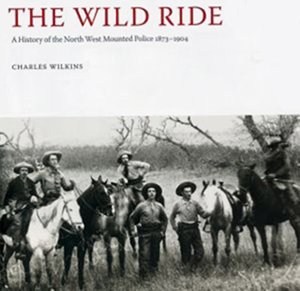The Wild Ride:
A History of the North West Mounted Police 1873–1904

Support Canada's History in other ways (more)
by Charles Wilkins
Stanton Atkins & Dosil Publishers, Vancouver, 2010
234 pp., illus., $45 hardcover
There is very little not to like about this book. It tells brightly written stories about the early years of Canada’s iconic police force, it is richly illustrated, and it is attractively laid out.
The book begins with a literal bang — the painfully long and drawn-out execution by firing squad of land surveyor Thomas Scott by the rebel forces of Métis leader Louis Riel in 1870. The West seems poised to descend into lawlessness and rebellion; the government of the new country of Canada responds by sending in the troops of the Wolseley Expedition, the nascent country’s first real effort to enforce the laws on its northwestern frontier.
Three years later, another dreadful act, the massacre of a band of Assiniboine at Cypress Hills by a gang of drunk American “wolfers” — so named for “hunting” wolves by poisoning bison meat with strychnine — prompted an emergency response by the Canadian government. A permanent police force for the Northwest was rapidly signed into law. Young men in Eastern Canada were recruited with lightning speed and sent west in the autumn of 1873, just as winter was descending on the land.
Charles Wilkins is unsparing in his description of how difficult it was for the fresh recruits — some had never before mounted a horse or fired a rifle — to make their way through the bogs of what is now northwestern Ontario in blizzards and freezing rain. In their haste, organizers of the 150-man expedition had failed to provide winter gear. No gloves, no hats, and boots that fell apart in the freezing water. By the time they reached Fort Garry (present-day Winnipeg) many were walking on bundled rags, fuelled by a sparse diet of rotten pork.
They persevered, however. They were the first of waves of law officers who would descend on the frontier over the decades, enforcing liquor laws, guarding railway construction sites, mediating disputes, bringing order to the goldfields, and even delivering the mail.
Wilkins pays special attention to the complex relationship between the North West Mounted and the indigenous peoples of the prairies. In the beginning, the men in red serge were appreciated for driving out the American whisky traders and bringing some order to a world increasingly marked by disease, starvation, and war. There was genuine friendship between Superintendent James Walsh and Chief Sitting Bull, who led his people into the relative safety of Canada to escape almost certain slaughter by American soldiers. The chiefs placed their trust in people like Commissioner James Macleod, who was responsible for bringing the Blackfoot Confederacy to the treaty table.
However, as more and more settlers arrived, relations between the police and the native people deteriorated. The NWMP were now enforcers who leaned on the tribal people to make them stick to their reserves. This became especially true after the Northwest Rebellion of 1885. Wilkins only mentions this less flattering image in passing, however. In the next chapter, the NWMP are back to being the incorruptible heroes who cleaned up the Yukon gold rush under larger-than-life Commissioner Sam Steele.
This is a feel-good book about the NWMP. There is probably no country in the world other than Canada that has elevated a police force to such a mythic status. Wild Ride goes a long way in explaining why this came about.
— Nelle Oosterom (Read bio)
Nelle Oosterom is the Senior Editor of Canada's History magazine.